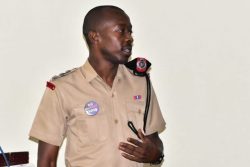Working People’s Alliance (WPA) member Dr Nigel Westmaas yesterday said that the party did not have the power to overthrown the Forbes Burnham-led PNC government and he flatly denied that he and other party members were involved in gathering arms and ammunition.
Dr Westmaas, a historian and sociologist who teaches in the United States, was at time testifying before members of the Commission of Inquiry into Rodney’s death, which he described an act of terrorism.
Led in his evidence-in-chief by commission counsel Latchmie Rahamat at the Supreme Court Law Library, Westmaas was asked if he was aware that the WPA was gathering arms and ammunition at any time between 1978 and 1980. He answered “no,” without hesitation. He had joined the party as an ordinary member sometime in the 1978. He said he was never given any arms or ammunition by any member of the executive of the WPA, nor did he ever see any members with these items.
He believed that the party was under surveillance and recalled that, under the authority a new national security law, his home was searched. He could not recall the exact date and time but he recalled that a party of five policemen entered his house and searched. He said they did stay long but particularly focused on his room. According to him, they were searching for arms and ammunition but they left without finding anything.
According to him, he was arrested about three or four times “for being in the wrong company” but he was never charged or placed before the court. He recalled that he would be locked in a cell for several nights before being released. He stated that in relation to his arrests, police sometimes acted on orders from above and did not sometimes know what they were arresting him for.
Westmaas said he was unaware of any plot to arrest the then Prime Minister Burnham. “Absolutely not. At that time that was considered inconceivable,” he said as persons in the audience laughed. He said the WPA lacked the power that the state had at that time and couldn’t possibly overthrow the state in that particular period.
He said that he was never privy to any plan of the WPA to overthrow the government. He also said after the death of Dr Rodney, he learnt that the WPA had an arm called the security committee.
Last week, WPA member Tacuma Ogunseye testified that the party planned to overthrow the then PNC government through a civil rebellion and attempted to win over the army as part of its efforts. His testimony was the first detailed account under oath by a senior WPA member of clandestine activities of the party. However, he said the party recognised that the rebellion would not bring down the government but would lay the foundation for a regime change.
Ogunseye also testified about the WPA’s set-up of a security committee, in the light of threats from the PNC. He said the security body consisted of Rupert Roopnaraine, himself and Rodney and operated on a “need to know” basis with other members. Ogunseye said the WPA started to build “cells” of members to further reinforce the security in the party. Twenty-five cells of members were developed in Georgetown, each having a maximum of five persons. The cells were charged with “covert” activities and he also said automatic weapons were collected and given to 12 cell leaders.
‘Life and death situation’
Westmaas said he was about 20 years old when he joined the party. He said his duties then included distributing leaflets, engaging the public during demonstrations, and picketing.
Following the June 13, 1980 death of Dr Rodney in a bomb blast, he said, he became the centre coordinator for the WPA office in Tiger Bay and his duties included interacting with the public, distributing Dayclean (newspapers) to activists, some accounting and distributing membership forms.
Like Ogunseye, he said there were confrontations at WPA meetings and he recalled his personal experiences between 1978 and 1980, including at a meeting at Vreed-en-Hoop on September 4, 1979, from where he said he and Roopnaraine fled for their lives.
He said that before the meeting started there was “a hustle and bustle” of people not connected to the supporters or membership of the WPA who were attempting to dislodge equipment. He said he saw one of the members “engaged in combat” while physically attempting to protect equipment. He said that some “thugs” were pulling down party equipment and at some point several party members ran to a vehicle.
According to him, they then noticed a Land Rover packed with people and some of the occupants were coming up to the vehicle where the WPA members were. He recalled that Roopnaraine said, “Let’s get out of here” with the equipment and they jumped into the vehicle and drove away.
Westmaas stated that at the time he was not able to identify these “thugs” but he later learnt that they were people recruited by the Office of Regional Development.
He said the Land Rover was in hot pursuit and he could see that some of the occupants who were inside were armed with weaponry – there were axe handles and cutlasses hanging out the side of the Land Rover. He said he and Roopnaraine tried to get across the Demerara Harbour Bridge to take the salvaged equipment back to party headquarters but they were cut off when they arrived at the bridge. As a result, they decided to head further south towards La Grange. He said the Land Rover was gaining ground and they ended up turning into La Grange.
According to Westmaas, they knew that they “were in a life-and-death situation” and eventually he and Roopnaraine abandoned the vehicle and ran in different directions. He said he ran into a cane field, where he stayed until he felt that the coast was clear. During that time, he said, he ate some cane and when night came he dug a small hole and pulled back the canopy and stayed there for most of the night until early morning. He said that he made it over the Demerara Harbour Bridge by dawn and caught a taxi. He headed back to the WPA office where Rodney asked him about the whereabouts of Roopnaraine. He said later they found their abandoned vehicle burnt and in a trench.
Undercover
Westmaas also recounted his experience at a meeting held in Campbellville in August 1979, which was broken up and from which they had to flee. He recalled that there was a massive turn out at that meeting. He did not believe the police had given permission for the meeting and he said that at some point police charged and people scattered in all directions.
According to Westmaas, he and Rodney were in a group of about 15 men who ran to the back of a house on the Railway Line, where they sat on a septic tank, played cards, talked about history and the political situation until the police dispersed.
He said he was not as fearful during this episode as he was in the Vreed-en-Hoop encounter.
The third encounter was at Linden, where they spoke with the working class, including bauxite workers, reassuring them that they would soon end the repression that they were experiencing. He said that they took extra precaution to travel to the mining town as they knew that if Rodney went there, it would be a “dangerous situation” as the area was a PNC stronghold. As a result, he said, Rodney disguised himself, as the idea was to go undercover into the town.
Meanwhile, Westmaas was asked whether he knew convict Robert Gates, who had earlier given evidence before the commission.
He said Gates would be with Roopnaraine at meetings and he later pointed him out from among those sitting in the audience yesterday. Gates had said that Roopnaraine wanted him to be his bodyguard.
At this point, Basil Williams, lawyer for the PNCR, questioned why Gates was still present at the hearing. “This is an unusual thing because we have witnesses who are here every day before they testify. Now we have a witness here who has testified but is still here when he is supposed to be in prison and he said there is no deal,” he pointed out.
Lead Counsel for the Commission Glen Hanoman stated that when the warrant was issued for the attendance of Gates, the commission was unsure when he would have given his evidence. “In a blanket fashion, the warrant included all the days,” he said, adding that Gates’ presence was because the prison authority did not want to take it upon itself to disobey the warrant issued by the commission.
Gates’ completed giving his evidence last Tuesday.
Under cross-examination by lawyer for Donald Rodney Keith Scotland, Westmaas said he believes there were untruths in the book written by Gregory Smith—the main suspect in Rodney’s death—and his sister. Reading from Smith’s book, Assassination Cry of a Failed Revolution, Scotland asked Westmaas whether he checked for the name William Smith—which Gregory Smith had said he used while filling out the WPA membership form.
Westmaas said that was no such name in the records and suggested that his claim to membership was untrue based on his investigations and records. He also said the names “Brother Yarden,” “Brother Fowler,” “Brother Morris” and “Brother Winston,” which were mentioned in Smith’s book, were not in the WPA’s archives and as far as he knew no member was referred to by any of those names. He said he knew of a Maurice not Morris.
He said it would be true to conclude from the records that those names listed by Smith in his book are “fictitious.”
The witness also said that Donald Rodney became a registered member of the WPA subsequent to June 13, 1980. He said his involvement up to that point was that he was the blood relative of Dr Rodney. He agreed that on June 13, 1980, he was just giving his brother a drop. He agreed that the planners of the event were not expecting Donald to be there that night.
Westmaas was cross examined by Andrew Pilgrim, lawyer for the Rodney family, Christopher Ram, lawyer for the WPA and Williams.
He returns to the stand today.









